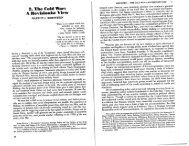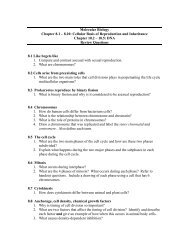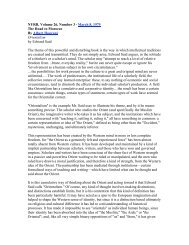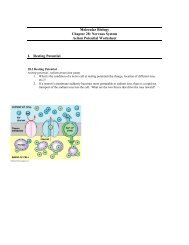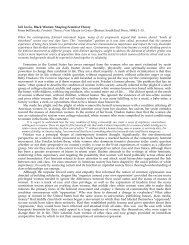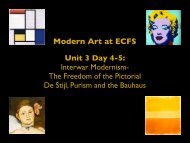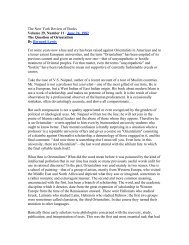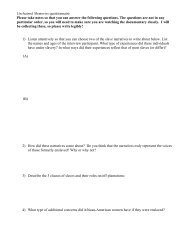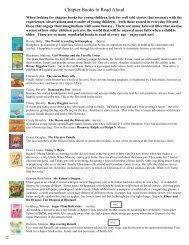Fire Brand, and putting it into the Matts with whichthey were covered, set the Wigwams on Fire.” WilliamBradford, in his History of the Plymouth Plantation written atthe time, describes John Mason’s raid on the Pequot village:Those that scaped the fire were slaine with the sword; some hewedto peeces, others rune throw with their rapiers, so as they werequickly dispatchte, and very few escaped. It was conceived theythus destroyed about 400 at this time. It was a fearful sight to seethem thus frying in the fyer, and the streams of blood quenchingthe same, and horrible was the stincke and sente there of, but thevictory seemed a sweete sacrifice, and they gave the prayers thereofto God, who had wrought so wonderfully for them, thus to inclosetheir enemise in their hands, and give them so speedy a victory overso proud and insulting an enimie.As Dr. Cotton Mather, Puritan theologian, put it: “It wassupposed that no less than 600 Pequot souls were broughtdown to hell that day.”The war continued. Indian tribes were used against one another,and never seemed able to join together in fighting the English.Jennings sums up:The terror was very real among the Indians, but in time theycame to meditate upon its foundations. They drew three lessonsfrom the Pequot War:(1) that the Englishmen’s most solemn pledge would be brokenwhenever obligation confficted with advantage; (2) that theEnglish way of war had no limit of scruple or mercy; and (3)that weapons of Indian making were almost useless againstweapons of European manufacture. These lessons the Indianstook to hcart.A footnote in Virgil Vogel’s book This Land Was Ours (1972)says: “The official figure on the number of Pequots now inConnecticut is twenty-one persons.”Forty years after the Pequot War, Puritans and Indians foughtagain. This time it was the Wampanoags, occupying the southshore of Massachusetts Bay, who were in the way and alsobeginning to trade some of their land to people outside theMassachusetts Bay Colony.Their chief, Massasoit, was dead. His son Wamsutta had beenkilled by Englishmen and Wamsutta’s brother Metacom (laterto be called King Philip by the English) became chief. TheEnglish found their excuse, a murder which they attributedto Metacom, and they began a war of conquest against theWampanoags, a war to take their land. They were clearly theaggressors, but claimed they attacked for preventive purposes.As Roger Williams, more friendly to the Indians than most,put it: “All men of conscience or prudence ply to windward, tomaintain their wars to be defensive.”Jennings says the elite of the Puritans wanted the war; theordinary white Englishman did not want it and often refusedto fight. The Indians certainly did not want war, but theymatched atrocity with atrocity. When it was over, in 1676,the English had won, but their resources were drained; theyhad lost six hundred men. Three thousand Indians were deadincluding Metacom himself. Yet the Indian raids did not stop.For a while, the English tried softer tactics. But ultimately, itwas back to annihilation. The Indian population of 10 millionthat was in North America when Columbus came wouldultimately be reduced to less than a million. Huge numbersof Indians would die from diseases, introduced by the whites.A Dutch traveler in New Netherland wrote in 1656 that “theIndians ....affirm, that before the arrival of the Christians andbefore the smallpox broke out amongst them, they were tentimes as numerous as they now are, and that their populationhad been melted down by this disease, whereof nine-tenthsof them have died.” When the English first settled Martha’sVineyard in 1642, the Wampanoags there numbered perhapsthree thousand. There were no wars on that island, but by 1764,only 313 Indians were left there.Block Island Indians numbered perhaps 1,200 to 1,500 in1662, and by 1774 were reduced to fifty-one.Behind the English invasion of North America, behind theirmassacre of Indians, their deception, their brutality, was thatspecial powerful drive born in civilizations based on privateproperty. It was a morally ambiguous drive; the need forspace, for land, was a real human need. But in conditions ofscarcity, in a barbarous epoch of history ruled by competition,this human need was transformed into the murder of wholepeoples. Roger Williams said, “it was a depraved appetite afterthe great vanities, dreams and shadows of this vanishing life,great portions of land, land in this wilderness, as if men werein as great necessity and danger for want of great portions ofland, as poor, hungry, thirsty seamen have, after a sick andstormy, a long and starving passage. This is one of the godsof New England, which the living and most high Eternal willdestroy and famish.”Was all this bloodshed and deceit—from Columbus to Cortes,Pizarro, the Puritans—a necessity for the human race toprogress from savagery to civilization? Was Morison right inburying the story of genocide inside a more important story ofhuman progress? Perhaps a persuasive argument can be madeas it was made by Stalin when he killed peasants for industrialprogress in the Soviet Union, as it was made by Churchillexplaining the bombings of Dresden and Hamburg, andTruman explaining Hiroshima. But how can the judgment bemade if the benefits and losses cannot be balanced because thelosses are either unmentioned or mentioned quickly?That quick disposal might be acceptable (“Unfortunate, yes,but it had to be done”) to the middle and upper classes of theconquering and “advanced” countries. But is it acceptable tothe poor of Asia, Africa, Latin America, or to the prisonersin Soviet labor camps, or the blacks in urban ghettos, or theIndians on reservation to the victims of that progress which85
enefits a privileged minority in the world? Was it acceptable (orjust inescapable?) to the miners and railroaders of America, thefactory hands, the men and women who died by the hundredsof thousands from accidents or sickness, where they worked orwhere they lived--casualties of progress? And even the privilegedminority—must it not reconsider, with that practicalitywhich even privilege cannot abolish, the value of its privileges,when they become threatened by the anger of the sacrificed,whether in organized rebellion, unorganized riot, or simplythose brutal individual acts of desperation labeled crimes bylaw and the state?If there are necessary sacrifices to be made for human progress,is it not essential to hold to the principle that those to besacrificed must make the decision themselves? We can alldecide to give up something of ours, but do we have the rightto throw into the pyre the children of others, or even our ownchildren, for a progress which is not nearly as clear or presentas sickness or health, life or death?What did people in Spain get out of all that death and brutalityvisited on the Indians of the Americas? For a brief period inhistory, there was the glory of a Spanish Empire in the WesternHemisphere. As Hans Koning sums it up in his book Columbus:His Enterprise:For all the gold and silver stolen and shipped to Spain did notmake the Spanish people richer. It gave their kings an edgein the balance of power for a time, a chance to hire moremercenary soldiers for their wars. They ended up losing thosewars anyway, and all that was left was a deadly inflation, astarving population, the rich richer, the poor poorer, and aruined peasant class.Beyond all that, how certain are we that what was destroyedwas inferior? Who were these people who came out on thebeach and swam to bring presents to Columbus and hiscrew, who watched Cortes and Pizarro ride through theircountryside, who peered out of the forests at the first whitesettlers of Virginia and Massachusetts?Columbus called them Indians, because he miscalculated thesize of the earth. In this book we too call them Indians, withsome reluctance, because it happens too often that people aresaddled with names given them by their conquerors.And yet, there is some reason to call them Indians, becausethey did come, perhaps 25,000 years ago, from Asia, acrossthe land bridge of the Bering Straits (later to disappear underwater) to Alaska. Then they moved southward, seeking warmthand land, in a trek lasting thousands of years that took theminto North America, then Central and South America. InNicaragua, Brazil, and Ecuador their petrified footprints canstill be seen, along with the print of bison, who disappearedabout five thousand years ago, so they must have reached SouthAmerica at least that far back.Widely dispersed over the great land mass of the Americas,they numbered 15 or 20 million people by the time Columbuscame, perhaps 5 million in North America. Responding tothe different environments of soil and climate, they developedhundreds of different tribal cultures, perhaps two thousanddifferent languages. They perfected the art of agriculture, andfigured out how to grow maize (corn), which cannot grow byitself and must be planted, cultivated, fertilized, harvested,husked, shelled. They ingeniously developed a variety of othervegetables and fruits, as well as peanuts and chocolate andtobacco and rubber.On their own, the Indians were engaged in the greatagricultural revolution that other peoples in Asia, Europe,and Africa were going through about the same time. Whilemany of the tribes remained nomadic hunters and food gatherersin wandering, egalitarian communes, others began tolive in more settled communities where there was more food,larger populations, more divisions of labor among men andwomen, more surplus to feed chiefs and priests, more leisuretime for artistic and social work, for building houses. About athousand years before Christ, while comparable constructionswere going on in Egypt and Mesopotamia, the Zuni and HopiIndians of what is now New Mexico had begun to build villagesconsisting of large terraced buildings, nestled in among cliffsand mountains for protection from enemies, with hundredsof rooms in each village. Before the arrival of the Europeanexplorers, they were using irrigation canals, dams, were doingceramics, weaving baskets, making cloth out of cotton.By the time of Christ and Julius Caesar, there had developedin the Ohio River Valley a culture of so-called Moundbuilders,Indians who constructed thousands of enormous sculpturesout of earth, sometimes in the shapes of huge humans, birds, orserpents, sometimes as burial sites, sometimes as fortifications.One of them was 3 miles long, enclosing 100 acres. TheseMoundbuilders seem to have been part of a complex tradingsystem of ornaments and weapons from as far off as the GreatLakes, the Far West, and the Gulf of Mexico.About A.D. 500, as this Moundbuilder culture of the OhioValley was beginning to decline, another culture was developingwestward, in the valley of the Mississippi, centered on whatis now St. Louis. It had an advanced agriculture, includedthousands of villages, and also built huge earthen mounds asburial and ceremonial places near a vast Indian metropolis thatmay have had thirty thousand people. The largest mound was100 feet high, with a rectangular base larger than that of theGreat Pyramid of Egypt. In the city, known as Cahokia, weretoolmakers, hide dressers, potters, jewelrymakers, weavers,saltmakers, copper engravers, and magnificent ceramists. Onefuneral blanket was made of twelve thousand shell beads.From the Adirondacks to the Great Lakes, in what is nowPennsylvania and upper New York, lived the most powerfulof the northeastern tribes, the League of the Iroquois, which86 <strong>fieldston</strong> <strong>american</strong> <strong>reader</strong> <strong>volume</strong> i – <strong>fall</strong> <strong>2007</strong>
- Page 4 and 5:
the federalist papers #51 (1787)...
- Page 6 and 7:
Inventing An AmericaCrèvecoeur Dis
- Page 8 and 9:
I say to you today, my friends, tha
- Page 10 and 11:
melodies of the Negro slave; the Am
- Page 12 and 13:
31.the encounterand north americasu
- Page 14 and 15:
Native American PoetryWHEN SUN CAME
- Page 16 and 17:
Pagans and Pilgrims in the Promised
- Page 18 and 19:
Reverend Doctor Sepulveda has spoke
- Page 20 and 21:
Juan Gines de Sepulveda:“The Grea
- Page 22 and 23:
Nathaniel Bacon: Bacon’s Declarat
- Page 24 and 25:
The sale of human beings in the mar
- Page 26 and 27:
seeking great things for ourselves
- Page 28 and 29:
Therefore, let every one that is ou
- Page 30 and 31:
frontier village she revised her ea
- Page 32 and 33:
Edward Taylor: Poems (1642—I729)L
- Page 34 and 35:
The Mayflower CompactNovember 11, 1
- Page 36 and 37: fly kites and shoot marbles, and to
- Page 38 and 39: Dominie Van Shaick, the village par
- Page 40 and 41: another man. In the midst of his be
- Page 42 and 43: Washington Irving:The Legend of Sle
- Page 44 and 45: a kind of idle gentlemanlike person
- Page 46 and 47: Tassel. In this enterprise, however
- Page 48 and 49: on the top of his nose, for so his
- Page 50 and 51: however, turned upon the favorite s
- Page 52 and 53: the green knoll on which stands the
- Page 54 and 55: so any nation, that discovers an un
- Page 56 and 57: indefatigable measures, the cause o
- Page 58 and 59: their heads on their shoulders inst
- Page 60 and 61: Metacomet Cries Out for RevengeIn t
- Page 62 and 63: Gustavus Vassa: The Interesting Nar
- Page 64 and 65: duct, and guard them from evil. The
- Page 66 and 67: particularly at full moons; general
- Page 68 and 69: that might come upon us; for they s
- Page 70 and 71: size of the finger nail. I was sold
- Page 72 and 73: intolerably loathsome, that it was
- Page 74 and 75: as he instinctively guessed its app
- Page 76 and 77: Document DSource: Articles of Agree
- Page 78 and 79: Next to manners are the exterior gr
- Page 80 and 81: Howard Zinn: Columbus, the Indians,
- Page 82 and 83: same token covet the possessions of
- Page 84 and 85: and culture, to ensnare ordinary pe
- Page 88 and 89: included the Mohawks (People Of the
- Page 90 and 91: It has been tempting to dismiss Jef
- Page 92 and 93: she found herself back in prison. M
- Page 94 and 95: 311.the struggle forindependence176
- Page 96 and 97: John Locke: of Civil Government (16
- Page 98 and 99: Daniel Dulany: “Considerations”
- Page 100 and 101: First Continental Congress, Declara
- Page 102 and 103: colonies enabled her to triumph ove
- Page 104 and 105: and America is a strong and natural
- Page 106 and 107: considerable pecuniary resources, b
- Page 108 and 109: He has combined with others to subj
- Page 110 and 111: Mary Beth Norton:Women in the Revol
- Page 112 and 113: testified, so “I was obliged to S
- Page 114 and 115: peace terms. And, tragically, Samue
- Page 116 and 117: not that this glorious threesome ne
- Page 118 and 119: less powerful than the rest, as it
- Page 120 and 121: paramount culture, but to many for
- Page 122 and 123: James Kirby Martin: Protest and Def
- Page 124 and 125: 3111.developing a frameworkfor gove
- Page 126 and 127: The Articles of Confederation (1777
- Page 128 and 129: 7. Whenever the Confederate Lords s
- Page 130 and 131: Darkness there, and nothing more.De
- Page 132 and 133: Edgar Allen Poe:The Fall of the Hou
- Page 134 and 135: of unnatural sensations. Some of th
- Page 136 and 137:
the full extent, or the earnest aba
- Page 138 and 139:
paused; for it appeared to me (alth
- Page 140 and 141:
Walt Whitman:Poetry Crossing Brookl
- Page 142 and 143:
101 Flow on, river! flow with the f
- Page 144 and 145:
41 Nor any more youth or age than t
- Page 146 and 147:
136 I am not an earth nor an adjunc
- Page 148 and 149:
13225 The negro holds firmly the re
- Page 150 and 151:
322 Patriarchs sit at supper with s
- Page 152 and 153:
415 And if each and all be aware I
- Page 154 and 155:
511 Voices of cycles of preparation
- Page 156 and 157:
27611 To be in any form, what is th
- Page 158 and 159:
702 Head high in the forehead, wide
- Page 160 and 161:
806 I go hunting polar furs and the
- Page 162 and 163:
908 Ten o’clock at night, the ful
- Page 164 and 165:
1001 I do not ask who you are, that
- Page 166 and 167:
1099 Believing I shall come again u
- Page 168 and 169:
1200 The great Camerado, the lover
- Page 170 and 171:
1294 And as to you Corpse I think y
- Page 172 and 173:
James Madison:The Federalist Papers
- Page 174 and 175:
James Madison:The Federalist Papers
- Page 176 and 177:
people are impliedly and incidental
- Page 178 and 179:
sort of people, who are orderly and
- Page 180 and 181:
Charles Beard: The ConstitutionA Mi
- Page 182 and 183:
Legislatures reflect these interest
- Page 184 and 185:
Staughton Lynd:The Conflict Over Sl
- Page 186 and 187:
France is an example. Jefferson had
- Page 188 and 189:
to the interior & landed interest,
- Page 190 and 191:
The first was to solve the problem
- Page 192 and 193:
there against mobs, demagogues, and
- Page 194 and 195:
3iv.the early republic: forging ana
- Page 196 and 197:
Alexander Hamilton and Thomas Jeffe
- Page 198 and 199:
employment to industrious individua
- Page 200 and 201:
Hamiltonian Federalists and Jeffers
- Page 202 and 203:
“As the present crisis of human a
- Page 204 and 205:
The Kentucky Resolutions of 1799The
- Page 206 and 207:
Washington’s Farewell Address,Sep
- Page 208 and 209:
equal law must protect, and to viol
- Page 210 and 211:
I sec.8, Congress has also been gra
- Page 212 and 213:
That the following amendments of th
- Page 214 and 215:
3v.the disgusting spirit ofequality
- Page 216 and 217:
Transcendentalism DefinedThough clo
- Page 218 and 219:
All are needed by each one;Nothing
- Page 220 and 221:
a long period continue, to rule is
- Page 222 and 223:
The broadest and most prevalent err
- Page 224 and 225:
clergyman whose preaching my father
- Page 226 and 227:
difference between resisting this a
- Page 228 and 229:
similar concern for the conditions
- Page 230 and 231:
few years I have been gravely disap
- Page 232 and 233:
In the midst of blatant injustices
- Page 234 and 235:
about the baby, whom she had hardly
- Page 236 and 237:
who, with conjugal affections and m
- Page 238 and 239:
a hut, tranquil, if in a crowd. The
- Page 240 and 241:
South Carolina Ordinance of Nullifi
- Page 242 and 243:
operation....The right to secede is
- Page 244 and 245:
Worcester v. Georgia and refused to
- Page 246 and 247:
effect in point of possession when
- Page 248 and 249:
hold the writer maintained with the
- Page 250 and 251:
986A narrow Fellow in the GrassOcca
- Page 252 and 253:
house.“You done talk too much wid
- Page 254 and 255:
Kate Chopin: The StormIThe leaves w
- Page 256 and 257:
IVAlcée Laballière wrote to his w
- Page 258 and 259:
When the letter reached Desiree she
- Page 260 and 261:
Her lip was beginning to tremble, a
- Page 262 and 263:
IIITheir eyes met, and she blushed
- Page 264 and 265:
een reversed.“Why, how do you do?
- Page 266 and 267:
of a juggler tossing knives; but th
- Page 268 and 269:
Having deprived her of this first r
- Page 270 and 271:
Sojorner Truth: Ain’t I A Woman?S
- Page 272 and 273:
Viewpoints of the Mexican WarThe fo
- Page 274 and 275:
evolt and sin...”Caleb Atwater, E
- Page 276 and 277:
encouraged this ideal of the perfec
- Page 278 and 279:
its own territory, with boundaries
- Page 280 and 281:
3vi.slavery, sectionalismand secess
- Page 282 and 283:
Charles W. Chestnut:The Passing of
- Page 284 and 285:
promptness and decision. “He’s
- Page 286 and 287:
left the hotel when a long‐haired
- Page 288 and 289:
and sent to the penitentiary. I tho
- Page 290 and 291:
Necessary Evil to Positive GoodSour
- Page 292 and 293:
Dred Scott vs Sanford (1857)The fol
- Page 294 and 295:
The Lincoln-Douglas Debates (1858)I
- Page 296 and 297:
DBQ: Free Soil, Free Labor, Free Me
- Page 298 and 299:
of the slave-holding system is to d
- Page 300 and 301:
“Why, not a cruel man, exactly, b
- Page 302 and 303:
Lincoln Denies Racial EqualityInter
- Page 304 and 305:
through an unseen multitude.“Ther
- Page 306 and 307:
that they intercepted, even for a m
- Page 308 and 309:
earded elders of the church have wh
- Page 310 and 311:
speak of. What! I have authority, I
- Page 312 and 313:
nothing to be shunned in the handso
- Page 314 and 315:
summer sun, it was his father’s c
- Page 316 and 317:
a human form appeared at intervals,



